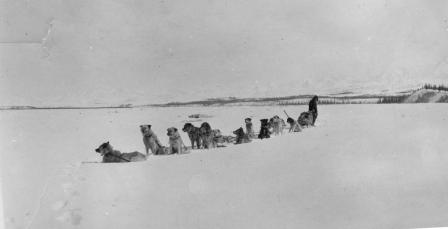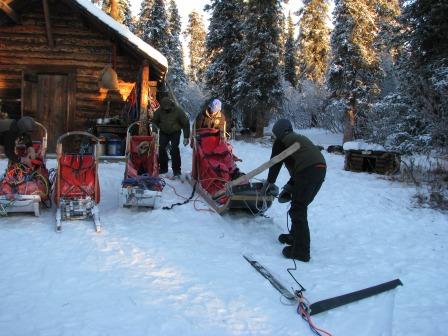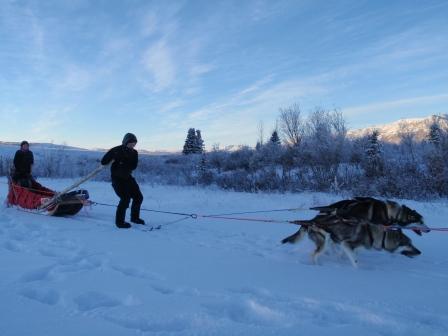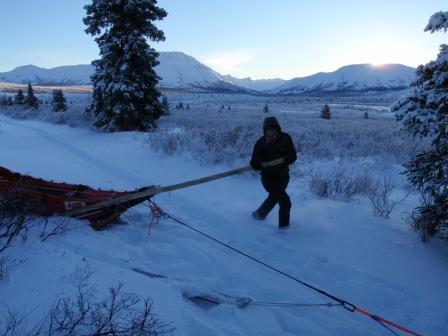Before this week's backcountry patrol, all I knew about putting a "gee pole" on the front of a dog sled was that it sounded dangerous. The gee pole is common in photos of sled dog freighting from the turn of the century, but extremely rare to see on the trails today. It is a long wooden pole lashed onto the right ("gee") side of a heavy dog sled and the musher walks, snowshoes or skis in front of it to steer the load. I was thinking the whole setup seemed sketchy because the braking system is at the rear of the sled where the musher usually stands. As a gee skier you could be dangling in front of the sled load like a fish on a hook if you fall off your skis and how would you stop the charging team?

Grant near Copper Mt" circa 1930. From the personal photo album of Grant H. Pearson, Denali National Park and Preserve Archive, DENA 3065 (DENA-00062)
No one who currently works at the Denali Park kennels had ever used this system before, and we were unsure of exactly how long ago the park staff stopped employing this old trick for traveling with heavy loads. As the mushing world turns more and more towards racing, we feel part of our mission here at Denali is not only preserving the genetics of Alaskan freighting dogs; but also to keep up the traditional freighting skills. Plus, it looked like it could prove pretty useful for us with the odd and heavy loads we often take by dog team.
This summer, the kennels manager connected with a man who was known for his gee pole talents and decided that our current winter staff (all competent skiers) was a good fit for learning this skill. Matt Emslie lived off the Alaskan road system for many years hauling ridiculously large loads around with his sled dogs in the Interior. Having recently re-located to Fairbanks, we invited him to go out on our first backcountry patrol and teach us what his gee pole system looks like on a modern sled.

Photo of setting up the gee pole
Unlike so many outdoor sports that require you to buy all sorts of specialized gear, to get a gee pole on the sled you need things you already have or can get for free at a neighbor's garage: a long wooden pole about 3" in diameter (fire killed spruce is ideal - lightweight and sturdy), some rope, an extra section of gangline, straight downhill skis from the 80s cut pretty short and bindings removed, and a mountain bike tire to make tread on the skis where the bindings used to be. To turn these items into a steering system 1) tie the pole securely onto the frame of the sled with three different points of attachment 2) drill a hole through both ski tips to tie a short length of rope from each ski up to the gangline behind the last dogs.
For all beginners (like us) you need to have a second person riding on the sled runners to brake and control the sled if you fall down. An experienced gee skier, like Matt, with lots of deep snow is just fine to ride the skis and steer the sled from the front with no one else helping.

Photo of using the gee pole
Ski skills do not directly translate into gee-ski skills. The gee pole skis are merely platforms for you to stand on as you rush over the snow. You cannot snowplow with 8 dogs pulling you and having no bindings means you can't get an edge in to turn them. Matt kept telling us it is very "Zen" - you need to relax, find your center of balance, and enjoy the ride. Some gee pole users (perhaps the snowboarders among us) prefer a single board (often called a "Ouija" board) that drags in front of the sled.

Photo of skier holding onto gee pole for dear life
I found it hard at first to find that Zen as you rush along on narrow skis with a 200 pound sled behind you. At first I held onto the pole for dear life - using the pole as my primary balance point as my legs wobbled around. Eventually you do find that sweet spot of putting your weight just a little back and your hand resting on the pole just to move it right or left. The sharp turns are challenging - but you can step off the skis and pull the pole all the way over as your brake person slows the sled down to a safe speed. This is the true advantage of no bindings to hold your feet on the skis - you can jump off and back on them whenever you need. Miki and Julie Collins (long-time local mushers) wrote that straddling the gangline on gee skis will give a musher a new respect for the courage our dogs have to jump back and forth across the line the way they do all the time.

Photo of sharp corner using gee pole to steer
The patrol season has begun and with it the tradition continues of the park kennels moving freight around the backcountry of the park. After two days of training, we are by no means experts in this old way of moving sleds - but we now have another trick in our bag of skills for freighting heavy loads this winter and in years to come. We think Harry Karstens, Grant Pearson, Bill Nancarrow and all the other Ranger mushers before us here would be happy to see the old ways continue alongside the new.
